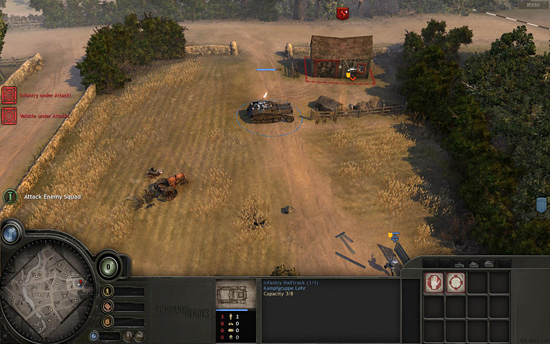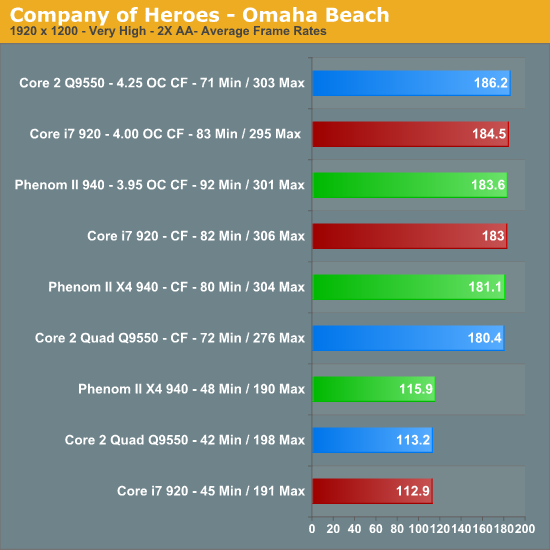CrossFireX and the Phenom II X4 940 – Competitive or Not?
by Gary Key on February 2, 2009 12:00 AM EST- Posted in
- Motherboards
Company of Heroes: Opposing Fronts

The oldest title in our test suite is still the most played. CoH has aged like fine wine and we still find it to be one of the best RTS games on the market. We look forward to the Tales of Valor standalone expansion pack this spring. In the meantime, we crank all the options up to their highest settings, enable AA at 2x, and run the game under DX9. The DX10 patch offers some improved visuals but with a premium penalty in frame rates. We track a custom replay of Able Company’s assault at Omaha Beach with FRAPS.

Just like our previous test results, we have very similar single card scores at 1680x1050. In this particular game, the Phenom II X4 940 offers the best minimum frame rates in each benchmark when compared to the Q9550 and surpasses the i7 in two tests. Only when the platform is overclocked do we see the Q9550 ahead of the Phenom II in average frame rates, a small 3% to be exact. However, the Phenom II has a 13% advantage in minimum frame rates.
Adding a second card for CrossFire operation improves average frame rates by 45% and minimum frame rates by 49% for the Phenom II. The Intel Q9550 has an improvement of 44% in the average and 81% in minimum frame rates. The Core i7 average frame rates improve by 48% and minimum rates increase 76%. Overclocking our processors resulted in a 5% average improvement in frame rates for our collective group, indicating we are largely GPU limited.
During testing, the Intel systems would generate minimum frame rates in the 23~24fps range on a couple of runs and then jump to their current results on the others. We noticed this in game play also; the Intel systems would hitch and pause at times. We would shutdown the game, clear the prefetch folder, and reboot. The game would operate fine in the next series of testing, though we still had stuttering in intensive ground scenes at times. We tried new images, different CPUs, memory changes, and the Sapphire HD 4870 cards with the same results. The Phenom II 940 had extremely stable frame rates in each test and action was very fluid during game play.

Lather, rinse, and repeat: the 1920x1200 numbers follow the same performance pattern once again - not that we expected anything different. Nevertheless, it is getting boring mentioning that same fact on every page. In single card testing the Phenom II 940 is 2% faster in average frame rates and 14% ahead in minimum frame rates compared to the Q9550. CrossFire results barely favor the Phenom II in average frame rates while minimum frame rates are about 8% better than the Q9550.
The i7 shows its strength in CrossFire testing in both average and minimum frame rates. We only experienced the previously mentioned drop in minimum frame rates a couple of times with i7 but it was still noticeable. The Q9550 finishes first again in average frame rates when overclocked but falls about 29% behind the Phenom II 940 in minimum frame rates.
Adding a second card for CrossFire operation improves average frame rates by 57% and minimum frame rates by 66% for the Phenom II. The Intel Q9550 has an improvement of 59% in the average and 71% in the minimum frame rates. The Core i7 average frame rates improve by 62% and minimum rates increase 82%. Overclocking our processors only improved frame rates 2% on average as we continue to be GPU bound at this resolution.
Now that we have discussed the numbers, what about the game play experience? As we alluded to earlier, the Intel platforms had problems with minimum frame rates throughout testing - not just in the benchmarks, but also during game play in various levels and online. We have not nailed it down yet, but we have noticed this problem consistently. In contrast, the Phenom II X4 940 had rock solid frame rates and offered the smoothest game play experience. The problem is very likely driver related in some manner (as the man who helped to start DirectX once put it, "the drivers are always broken"), but nevertheless this is an issue on the two Intel platforms.










68 Comments
View All Comments
balancedthinking - Monday, February 2, 2009 - link
If these Settings were used for the Phenom II 940, at least it is not as bad as I first thought:http://www.anandtech.com/weblog/showpost.aspx?i=55...">http://www.anandtech.com/weblog/showpost.aspx?i=55...
That would mean an NB frequency around 2450. That is quite okay though it can be tweaked a bit further.
Still, it would be nice to know which settings were actually used for the Phenom II.
hooflung - Monday, February 2, 2009 - link
That is a very, very well done article. Keep it up guys. Can't wait til' income tax and I am going to get a e8500 and a pII 940 to upgrade my P35 and 790GX, respectively.7Enigma - Monday, February 2, 2009 - link
Thank you for finally including this information in the charts!This has been a HUGE peev of mine for a while now and it really helps to see which card (or in this case system) is actually better than the other at a particular game where the average frame rate may not tell the whole story.
Please make sure the rest of the Anandtech crew starts using this format for future testing.
CPUGuy - Monday, February 2, 2009 - link
Although I understand the intent of using the highest OC possible I do believe the results can lead to another conclusion. A few of us discussing the CPU OC, CF results. It appears (so far) that the reason why the Q9550 came out ahead in CF results was a direct result of it's overclock. Some believe that if the PII 940 was OC'd that high (yes we read the other article about this) or the Q9550 was OC'd down, results would be different.The reason for this point of view is that most are not able to get Q9550 at 4.25GHz on air.
jusme - Monday, February 2, 2009 - link
I found this article very informative. It now puts into perspective where the PII 940 stands in the gaming arena. Thanks Anandtech for taking the time to do it. I myself have 3 computers, 2 capable of of either the quad 9550(P45) or PII 940 Deneb(780g). It is very good to know that which ever solution I choose, xfire on P45 or single on 780g, I know the performance capabilities of both, and I like both. Hell, you got that Q9550 up to 4.05 oc for these tests? Wow! I knew they were capable, but to run these games that well under the load is alone impressive. You sure it was'nt the Q9650? I alone was going to shoot for a modest 3.8 for gaming, stability and temp management. In closing, it is also good to know that those who jumped on the I7 bandwagon real fast are sitting pretty, I know it was'nt cheap, but alot of those builders skimped on graphics.zenguy - Monday, February 2, 2009 - link
In your review, it you stated that your testing did not reveal any difference between the P45 and P48 for CrossFire Limits so a P45 board was chosen.However, based on a few other reviews I have read, the 4850 can be noticably limited by the P45 board and ergo I presume the limits on a 4870 1GB card would be much much higher.
An example of one such review is below...........
http://www.tweaktown.com/articles/1472/10/intel_p4...">http://www.tweaktown.com/articles/1472/...s_x48_cr...
Could this explain the "Unusual Drop" in performance or unexpected low framerates for the Intel Platform that you noted?
AtenRa - Monday, February 2, 2009 - link
I am 100% sure that the results of the Core 2 Quad 9550 wild be much higher with an Intel X48 chipset than with the P45 in Cross Fire.Never the les, the article DOES show that Phenom II 940 is competitive in real life gaming at High resolutions.
zenguy - Monday, February 2, 2009 - link
Yes the PII is a valid solution.AMD Finally re-entered the game in my Mind with the release.
SLI - Monday, February 2, 2009 - link
Hammonds famous line in Jurrasic Park.Indeed, for 95% of folks, these ultra high benchmarks are useless. But for those of us in the 5%, thesy serve as a reminder on the ridiculous amounts of money we spend to squeeze just tha extra few FPS out. But then again the other 95% just dont get it...why?
Here is a paragraph I have kept near and dear for some years and it explains it eloquently.
"To upgrade or not to upgrade, that is the question that crosses many enthusiasts' lips on a daily basis. The upgrade bug is a high infectious, wallet-stripping disease that spreads fast once it gets a hold of you. Hardware manufacturers propagate this infection by offering you, the consumer, faster, more desirable hardware each month. Almost every facet of the hardware world begs you to get the next model up, or to break open the piggy bank and buy an 'upgraded version' of what you already have. Speak to a number of enthusiasts and they'll tell you that upgrading is more addictive than gambling (Biz387, 2003)."
So, you see, it's not our fault. Were simply sick. I type this as I play crysis at DX10 Very High spec everything at maximum @ 1900x1200@ 40fps average. Pulling about 830watts at the outlet, lol.
CPUGuy - Monday, February 2, 2009 - link
If I were to use your number, the inclusion of more mainstream benchmark results pulls in nearly 95% more hits to this website then it would be beneficial for both anandtech and it's viewer base. Puts things into prospective doesn't it? LOL